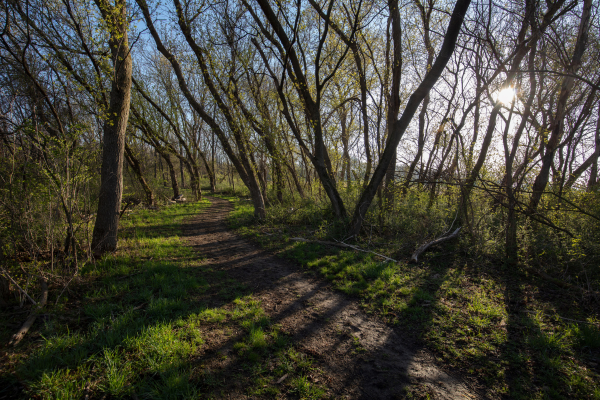Photo by Tom Schmock
Mud Season on the Ice Age Trail
Snowmelt and spring rains lead to muddy trails and flooding along the Ice Age National Scenic Trail. Learn more about hiking during mud season and its impact on the Ice Age Trail.
What is Mud Season?
Mud Season is the name given to the period of time between winter’s end and early spring, usually between the months of March and May. Snowmelt, freeze and thaw cycles, and spring rains lead to waterlogged soils and muddy conditions on hiking trails during this time.
How does hiking in Mud Season impact the Ice Age Trail?
Ice Age Trail Alliance Trail Program Manager, Dave Caliebe, shares insights about how mud season hiking impacts the Ice Age Trail.
Trails are more fragile in the spring
“As the snow melts and ground thaws, the Ice Age Trail softens up, and it’s easier to create ruts in the Trail. Ruts fill with water and form puddles, and people avoid them by going around them, which widens the trail. Heavy use on the Trail in really wet conditions causes more vegetative disturbance, soil disturbance, and erosion. If you see a wet area or a puddle, hike through it, don’t hike around it.“
The Ice Age Trail is open during Mud Season
“We don’t close the Ice Age Trail in the spring. When the Trail is constructed sustainably, it will be able to withstand more use in wet times. We also have a great group of volunteers who go out and maintain sections of the Trail once they dry out. However, it is helpful to avoid hiking after heavy rains at any time of the year. Even giving it a day will help.”
Choose your hike wisely
“The nice thing about the Ice Age Trail is you are always near one or two other segments, so you can always pick and choose which segment you want to hike. Areas that are more upland are going to be drier and will shed water better. Areas with sandier soil also dry out quicker, such as places like Waushara county, Waupaca county, a lot of the Central Sands counties.”
Thank you for protecting the Ice Age Trail!
Mud Season Hiking Tips
Hiking during mud season often increases erosion and damage to trails and vegetation, but there are ways to mitigate harm. Hikers should prepare for muddy conditions while hiking in the spring and adhere to the following guidelines to reduce damage to the Ice Age Trail.
1) Stay on the Ice Age Trail corridor
Hikers may try to escape water and mud by creating a path around muddy areas. To protect the integrity of the Ice Age Trail and plant life, walk single file down the center of the Trail and through the mud puddle. Get dirty and enjoy mud season! You may be tempted to walk along the sides of the Trail to keep your feet dry, but doing so loosens soil next to the tread and makes the trail more susceptible to erosion. Walking outside of the trail corridor also damages habitat along the Trail, which is magnified when others follow the alternative route over time.
2) Expect muddy and slippery conditions
Prepare to get dirty! Hiking in the spring is inevitably muddy. Trekking poles, waterproof hiking shoes with pronounced tread, and gaiters are helpful accessories to prevent slipping on muddy trails and minimize wet, muddy legs and feet. On icy days, consider wearing attachable microspikes to the bottom of your boots. Use extra caution on boardwalks, as they can be especially slippery when wet or icy! To avoid extra muddy conditions, hike right away in the morning before the ground softens up.


3) Explore new Ice Age Trail segments
Segments of the Ice Age Trail in upland areas will be drier than segments that pass through wetlands: lowland areas will be especially susceptible to flooding and boggy conditions. Consult the Ice Age Trail Guidebook for in-depth details on which segments pass through lowland areas. Consider exploring an Ice Age Trail Community or a segment that overlaps with paved or gravel multiuse paths during the spring months!
4) Pack layers
It may seem chilly out at first, but while walking on the Trail, you can still work up a sweat in 45- to 60-degree weather. Remember to wear layers and de-layer or re-layer as needed throughout your hike. Additional items to include in your pack include a rain coat, an extra pair of socks, gloves/mittens, water bottle, first aid kit, cell phone, and a map or atlas.
5) Beware of Ticks and Tick-Borne Diseases
Even though it is early in the year, ticks become active as early as March when snow melts and the weather warms up. See our six tips for reducing exposure to ticks and remember to check yourself and your pets after hiking on the Trail!
View our Trail Alerts interactive map for up-to-date Trail conditions and closures
Enjoy your springtime Ice Age Trail adventures!




